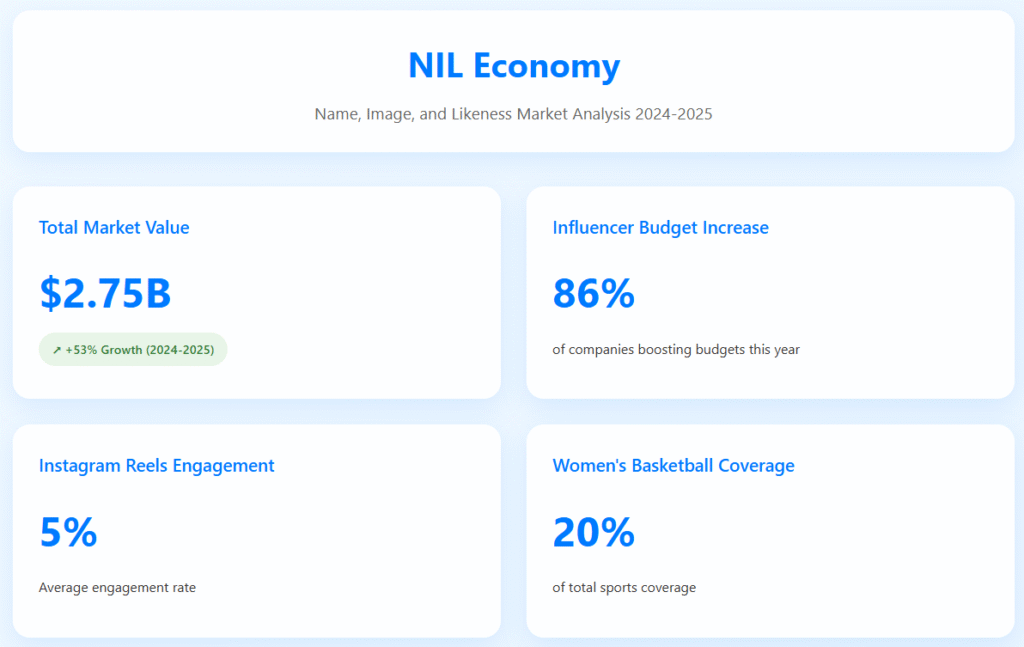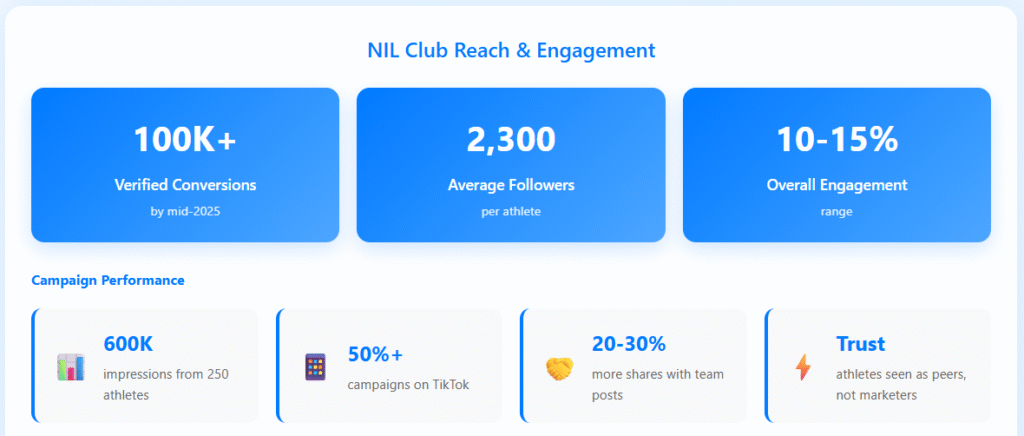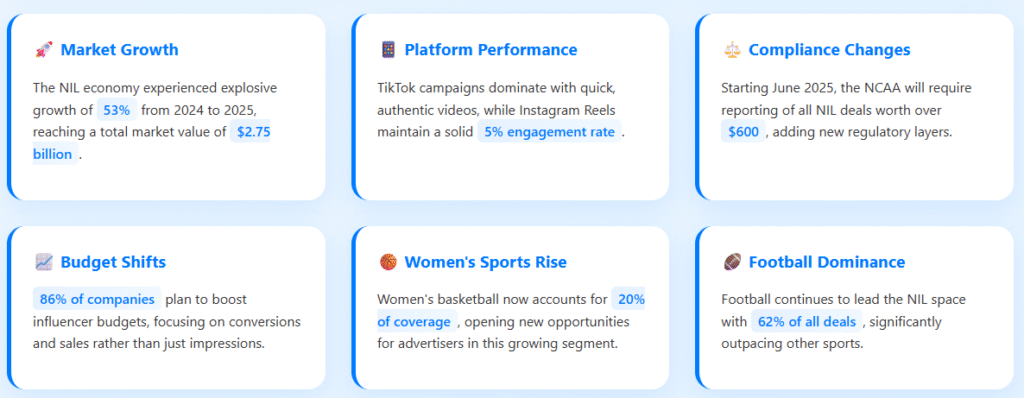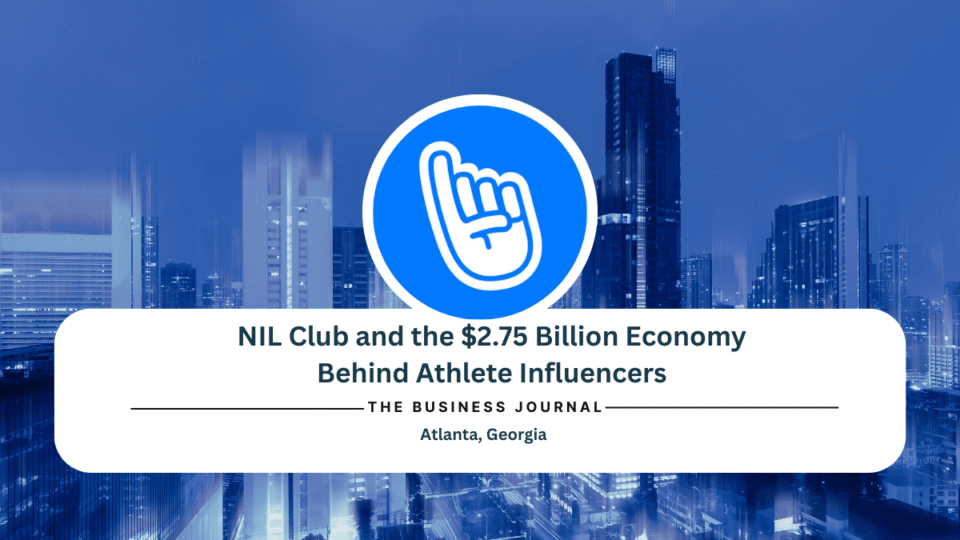For a long time, endorsements from athletes were based on big names and even bigger budgets. Expectations have evolved in tandem with the audience. That way of doing things no longer works the same way. Fans want to hear from athletes directly, not through polished ads. They respond to quick TikTok clips, behind-the-scenes photos, and unscripted product shoutouts that feel genuine. Today, the best partnerships are based on trust, not billboards.
The numbers prove it. Student-athletes generate engagement rates between 10% and 15% on social media, compared to just 1% to 3% for traditional influencers. That gap explains why brands are moving away from broad sponsorships toward direct, athlete-driven relationships that feel personal and authentic.
Projections indicate that student-athletes will generate nearly $1.95 billion in revenue from name, image, and likeness (NIL) deals by 2026. They have become strong advertising partners, providing brands with a sense of authenticity that traditional influencers may struggle to offer.
Enter NIL Club by YOKE, a platform designed to connect brands with this network of athletes. It promises measurable results, but how well does it work in practice? Let’s break it down.
The Rise of Athlete Influencers
The NIL economy is booming. From 2024 to 2025, it grew by 53 percent, reaching a total of $2.75 billion in spending.
Football dominates the field with 62 percent of deals. Men’s basketball holds 17 percent, women’s basketball 10 percent, and sports like volleyball, track, and swimming fill in the rest.

Brands are shifting, too. Eighty-six percent of companies say they’ll boost influencer budgets this year. The focus is shifting away from impressions and toward tangible results, such as conversions and sales.
Instagram Reels average around 5 percent engagement, while TikTok campaigns tend to dominate with quick, authentic videos. Women’s sports are gaining ground as well. Basketball now accounts for 20 percent of coverage alone, opening new opportunities for advertisers.
But compliance is becoming more important. Starting in June 2025, the NCAA will require the reporting of all NIL deals worth over $600. Different rules in each state add more layers of regulation. Platforms like NIL Club help brands maintain compliance and offer athletes a structured participation option.
NIL Club’s Core Model
Founded in 2019, NIL Club operates under YOKE, a fan-engagement software company that has transitioned into the NIL space.
The platform now connects 650,000 athletes from over 20,000 teams, creating a combined social media footprint of 1.5 billion followers.
Here is how it works. Athletes join team-based clubs, share content such as training clips, behind-the-scenes updates, and game day moments, and then split earnings from fan subscriptions. Pay-what-you-can-afford subscriptions, typically ranging from $5 to $20 per month, are the basis of the model.
This team-focused model encourages collaboration instead of solo sponsorship deals. It also feels more authentic for fans, who get access to group-generated content rather than polished ad campaigns.
Before allowing any students to sign up for an NIL Club in a state, legal experts review that state’s bylaws and rules. This ensures that participation is in compliance with both NCAA rules and local laws. After receiving the green light, YOKE staff and school representatives review every brand deal to ensure no rule violations. Brands access opportunities through the Brand Deals tab, which launched in August 2025.
From there, athletes can browse offers, claim opportunities, and promote them either within the app or across their personal social channels.
NIL Club also integrates with tracking tools like Impact and Awin, providing brands with transparent data on clicks, conversions, and ROI. The app has garnered around 10,000 downloads and a 4.5-star App Store rating based on over 5,000 reviews, indicating widespread adoption but leaving room for further growth.
Campaign Options for Brands
NIL Club offers three main ways for brands to run campaigns. Each one is performance-based:
1. Cost-Per-Action (CPA)
Brands only pay when an athlete achieves a clear result, such as a purchase or an app sign-up.
2. Commission and Affiliate Programs
Athletes receive a cut of the sales, typically ranging from 5% to 15%. The ‘Brand Deals’ tab shows offers, and athletes can share them on their channels with custom links.
3. Product Seeding
Brands send products to at least 250 athletes, usually for about $50 each. In exchange, athletes create unboxing and review content that feels natural to their audiences. Beauty and lifestyle brands often use this, although the volume minimum can be a hurdle for smaller companies.
CPA and affiliate campaigns have no minimums, making them more flexible and adaptable. Seeding works best when brands want large-scale visibility.
Reach and Engagement
By mid-2025, the NIL Club had powered more than 100,000 verified conversions, demonstrating its ability to go beyond views and deliver actual sales.
The average athlete has 2,300 followers. Most campaigns rely on Instagram Reels (5 percent engagement) and TikTok, which hosts more than half of the NIL Club’s campaigns.

Overall engagement sits in the 10 to 15 percent range. Fans trust athletes because they see them as peers, not marketers.
A typical seeding campaign with 250 athletes generates about 600,000 impressions. When teams post collectively, shares increase by 20 to 30 percent compared to solo posts.
There are challenges. Athletes don’t always post consistently during their seasons, and algorithm changes can cut reach in half. Still, NIL Club’s performance has remained consistent compared to other influencer platforms.
Success Stories
Brands like SoFi and Amazon have already used NIL Club with success.
For SoFi, the exact results tied to NIL Club remain private. However, the company reported adding a record 850,000 members in the second quarter of 2025, bringing total membership to more than 11.7 million, up 34 percent from 8.8 million at the end of the same period the prior year. This growth demonstrates the promise of brands aligning with athlete-driven engagement.

Amazon has also leveraged the platform to build visibility among younger audiences, using athlete-generated content to drive organic interest and credibility.
Other consumer brands in lifestyle, fashion, and beauty have also engaged athletes through the NIL Club, creating authentic content and new pathways to connect with Gen Z. While exact numbers are private, these collaborations illustrate how the platform can scale across various industries.
Public sentiment supports these partnerships. Surveys indicate that over 50% of U.S. adults back athlete brand collaborations, reinforcing the value for companies that invest in this space.
Is NIL Club Worth It?
For brands, NIL Club’s value lies in scale and cost control. With 100,000 conversions already on record, it has demonstrated its ability to deliver results.
Engagement rates outperform those of traditional marketing campaigns, and the compliance-first structure mitigates legal risks. Mid-sized brands, in particular, benefit because they can access hundreds of thousands of athletes without paying premium rates for mega-influencers.

That said, challenges remain. Product seeding requires large budgets, inconsistent athlete participation can weaken campaigns, and algorithm changes create unpredictability.
Still, NIL Club’s pay-for-results model is strong. The best strategy is to start with CPA, evaluate performance, and then expand. Carefully executed campaigns typically yield a 2x return for brands.
The Bottom Line
The NIL market is growing rapidly, and NIL Club is one of the leading platforms.
It provides brands with a compliant and transparent way to connect with 650,000 athletes and reach 1.5 billion followers. At the same time, it provides athletes with opportunities to earn in meaningful ways.
The hurdles, from scale requirements to shifting algorithms, are real but manageable. For brands targeting Gen Z sports fans, the rewards outweigh the risks.
As new NIL reporting rules take effect in 2025, platforms like NIL Club will play an even greater role in shaping athlete advertising. Adapting brands will thrive, while those adhering to outdated strategies may fall behind.

